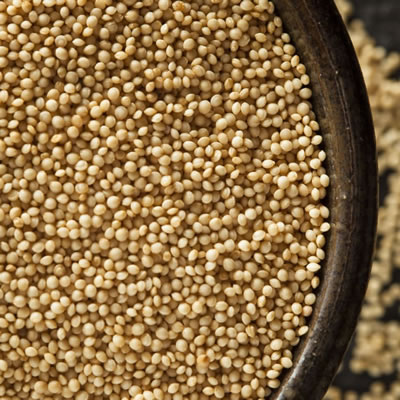
Amaranth Flour
What is Amaranth Flour?
Amaranth flour is a specialty flour derived from the amaranth, a plant native to Mesoamerica that’s cultivated throughout North and South America.
The flour of this small pseudocereal is typically used in specialty, multigrain baking mixes. It can also be used in flat and leavened breads including gluten-free formulations.1
Origin
The seed of a plant native to Mesoamerica and cultivated throughout North and South America, grain amaranth is touted for its high nutritional value. It is also known as “prince’s feather.” The flour is traditionally used to make tortillas, pastries and tamales. Some of these items were made and eaten by the Aztecs and other cultures as part of their religious observances.2
The most common cultivar is A. hypochondriacus. In the United States, consumption is reportedly hampered by lagging research and a lack of a stable, uniform supply.3 “It will probably remain a specialty market rather than a mass market for quite some time,” Octavio Paredes-Lopez said in Amaranth Biology, Chemistry, and Technology.1
Function
Grain amaranth can be used in breakfast foods, bread, multigrain crackers, and pancake mixes. Experts contend more research and work is needed in product development, commercialization and marketing for it to be more widely used.4
Nutrition
Amaranth flour has a protein content ranging between 14.5 and 17.8 percent. It also contains high amounts of lysine.6
Commercial production
Milling is difficult because of its smaller structure. One amaranth milling experiment involved passing it through a barley pearler. The flour comes in several forms: whole, high and low bran.1
Application
Amaranth flour is one of several specialty flours available for use as an ingredient. However, special care is needed for it to be successfully incorporated into a formula, according to Michael Suas and Frank Wing in Advanced Bread and Pastry: a Professional Approach. The amount used in bread or other baked goods should be monitored and tested. Using roughly 20 percent of the total flour volume is suggested as a starting point, but “only a good deal of experimentation … will determine the exact amount to use to get the best balance between optimum dough characteristics, desired appearance, and flavor for the finished product.”5
Amaranth flour needs to be incorporated into dough during the pre-ferment stage as it is at this point that it and other specialty flours is changed by yeast. It is also the stage during which a weak flour will weaken more, which Suas and Wing say is a desirable reaction. “This will create dough with a higher-quality gluten structure and breads with nicer appearance and superior volume.”5
Although recommended for use in quantities of up to 15 percent, which reportedly do not affect the physical and sensory qualities of bread, varying amounts of amaranth flour are suggested by different research studies. Some found breads with 10 to 16 percent amaranth flour had little effect on bread quality, while 10 percent resulted in darker bread. Bread had a significant softer crumb texture in comparison with the control loaves.4,1
- In tortilla formulations, it was used, in part, to replace nixtamalized corn flour, which resulted in an increased nutritional profile for the final product without significant sensory changes.
- In crackers, the replacement amount evaluated was 20 percent.4,1
- It has been evaluated for use in various gluten-free products, including biscuits, pasta, and bread. When used in small amounts, it is reported to improve dough workability and bread crumb volume.6
Researchers also evaluated using a combination of raw and popped amaranth flour in baked goods. In bread, for example, a formulation consisting of roughly 65 percent popped amaranth flour and 35 percent of raw amaranth flour resulted in loaves with homogeneous crumb and higher specific volume compared to other gluten-free breads. They also examined formulations for cookies, finding the best result was achieved by using 20 percent of popped amaranth flour and 13 percent whole-grain popped amaranth.4
A baker needs to understand how amaranth flour works and adjust the baking process accordingly, conclude Suas and Wing. Modifications will be needed through the process to achieve a good loaf of bread.5
FDA regulation
In May 1993, the United States Food and Drug Administration determined amaranth was a traditional food. Thus, it is not required to have generally recognized as safe status.1
References
- Paredes-Lopez, O. Amaranth Biology, Chemistry, and Technology. CRC Press, 2018.
- International Rice Commission Newsletter Vol. 48, FAO of the UN, www.fao.org/docrep/t0646e/T0646E0b.htm#Amaranthus cruentus, Amaranthus hypochondriacus. Last accessed 10 December 2018.
- Wrigley, C. W., et al. Encyclopedia of Food Grains. 2nd ed., Academic Press, 2016. pp. 287-296.
- Malin, S., and L. Nilsson, editors. Starch in Food: Structure, Function and Applications. 2nd ed., Woodhead Publishing, 2018. pp. 530-531.
- Suas, M., and F. Wing. Advanced Bread and Pastry: a Professional Approach. Cenage Learning, 2012. pp. 152-153.
- Mandala, I., and M. Kapsokefalou. “Gluten-Free Bread.” Flour and Breads and Their Fortification in Health and Disease Prevention, 2011, pp. 161–169., doi:10.1016/b978-0-12-380886-8.10015-7.

